What are Rich Snippets and How to Get Them?
There’s been a lot of talk about rich results or rich snippets recently, and it’s no surprise. They have changed the look and feel of Google’s SERPs beyond recognition. Thanks to rich snippets, today’s SERPs look more informative and appealing to users. At the same time, these innovations give marketers a hard time, because they have to get more technical and invest more effort in their SEO activities.
This article will help you sort things out to form your own opinion. You’ll learn what rich results are, how to get rich snippets, and how to benefit from a fancy presentation of your pages on SERPs.
Key takeaways
- Rich snippets are visually enhanced search results that display additional information from the page. They make SERPs more informative and appealing and can include reviews, ratings, prices, images, and other relevant details.
- Adding structured data markup to the pages on your website makes them eligible for rich snippets. Google recommends using JSON-LD format when implementing structured data.
- Rich snippets can improve click-through rates, drive more targeted traffic, provide a competitive advantage, and enhance the user experience by allowing users to complete actions directly from SERPs.
- Various rich snippet types are available for numerous industries and page types, such as products, recipes, events, jobs, software applications, videos, carousels, and more. Local businesses can benefit immensely from the rich snippets displayed in local packs.
- To get rich snippets, identify relevant schema markup types for your pages, add the JSON-LD script with required properties, validate it using Google’s Rich Results Test, and submit the page for indexation through Google Search Console. Implementation methods vary based on the websites’ CMS platform.
- Maintain visibility in rich results by monitoring rich snippet performance, keeping markup updated, and troubleshooting issues through Google Search Console.
- As rich snippets continue to evolve and expand, it is becoming increasingly important for businesses across industries to optimize for them to stay competitive in search results.
What are Google rich snippets or rich results?
Google uses special algorithms to generate rich snippets. Most of the time, these algorithms rely on the structured data provided by website owners. However, even if a page doesn’t have structured data, Google can still show rich snippets based on the page’s content alone.
The goal of Google’s algorithms for generating rich results is to make SERPs more informative and help users find exactly what they are looking for.
Simply put, a rich snippet is a visually enhanced type of search result that displays additional information from the page instead of showing a standard snippet containing title, description, and URL.
To illustrate what “visually enhanced” means, let’s compare regular and rich snippets for product pages from online stores. In the image below, you can see that even the simplest type of rich snippet stands out compared to a regular snippet. It does this by showing the product details people care about, such as price, availability, and review ratings.
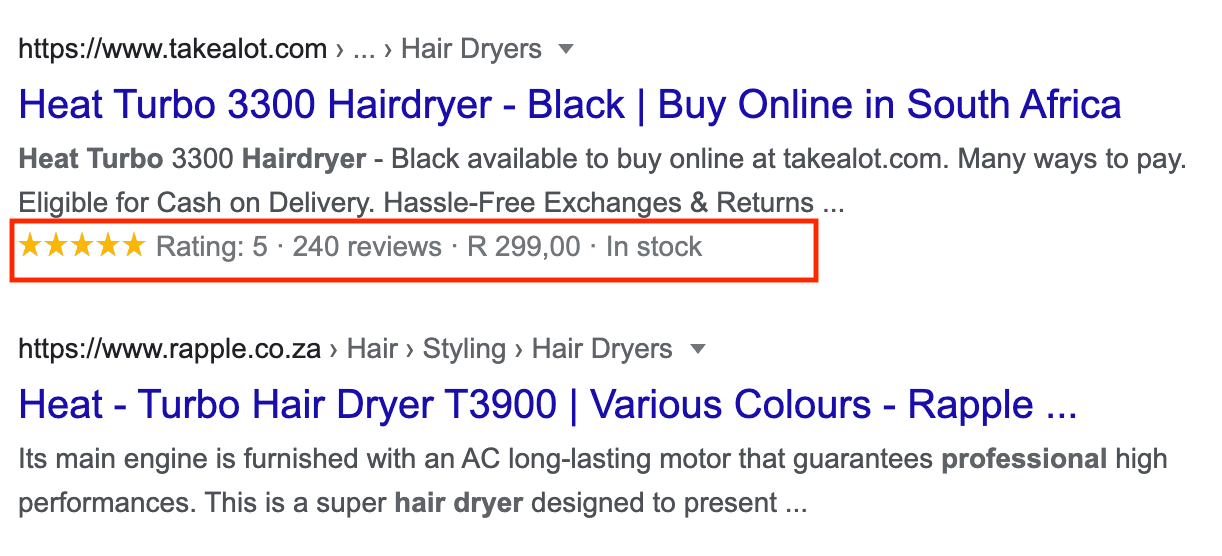
Yet, even the above-mentioned simple Product rich snippet pales in comparison to the Popular Products enriched search result. This advanced type of rich snippet leverages the design, adds interactivity to SERPs, and looks very unusual:
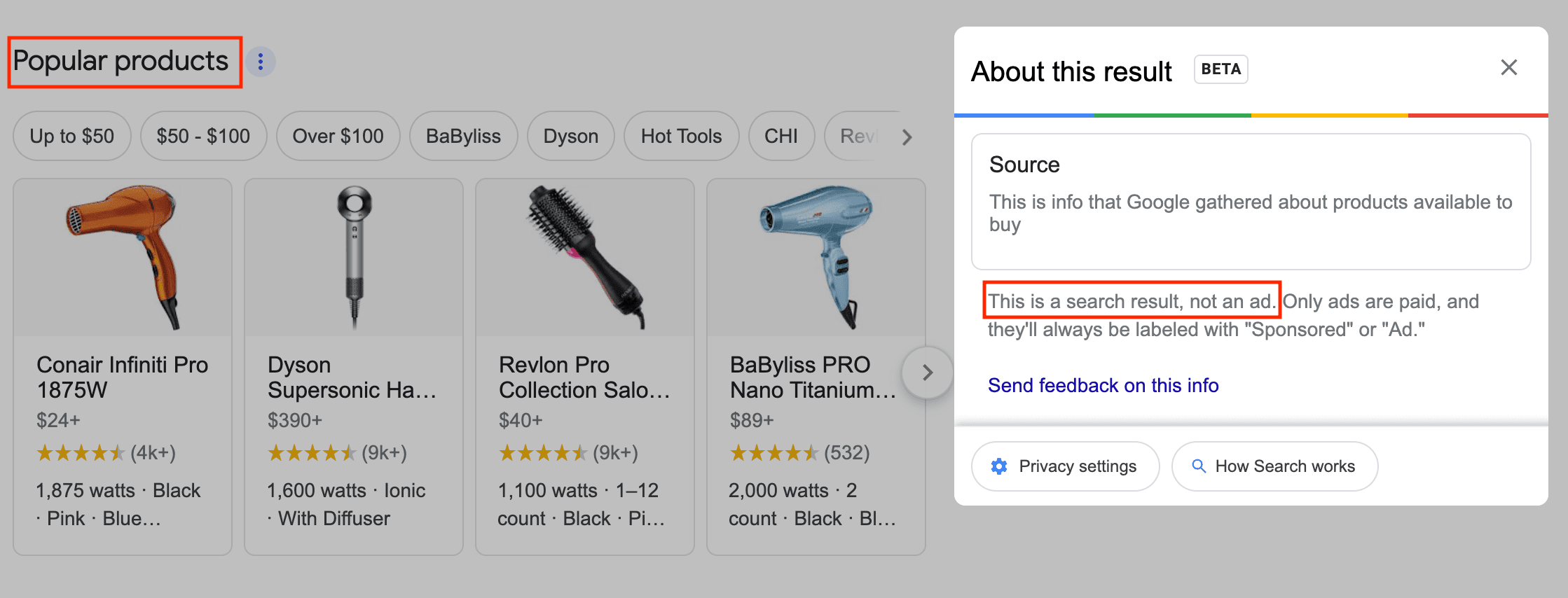
People can even mistake such snippets for an ad because of the fancy design. To clear things up, Google explains in the About this result feature that they haven’t been paid to highlight those products on the SERP.
As you can see, Google rich snippets change and improve over time. Moreover, they are not the only visually enhanced feature on Google’s SERPs. That’s why, before we move any further, we need to make sure we are speaking the same language.
How to find if you are ranking for rich snippets?
Currently, Google Search Console can show statistics on the number of impressions and clicks for 24 types of rich results. You can analyze click-through rates for different rich snippets and see which ones generate the most traffic to your website.
You also can use Search Console to spot flaws in your structured data. Under Improvements, you’ll see reports for every structured data type on the issues and errors that Google detects on your pages. By clicking one of the errors, you’ll be able to figure out what page contains it and what scripts you should edit to fix it.

You can use SE Ranking’s Keyword Research tool to collect keywords. Pay attention to the SERP features that get displayed for every suggested keyword. You’ll find them in a separate column on the Similar and Related keywords charts under Keyword Suggestions.
Find more types of rich snippets to go for with SE Ranking
Search Console gives you an idea about the performance of rich snippets that you already own. But you might want to have a tool for finding new opportunities to optimize for rich snippets. This is when SE Ranking’s SEO keyword tracker can come in handy.
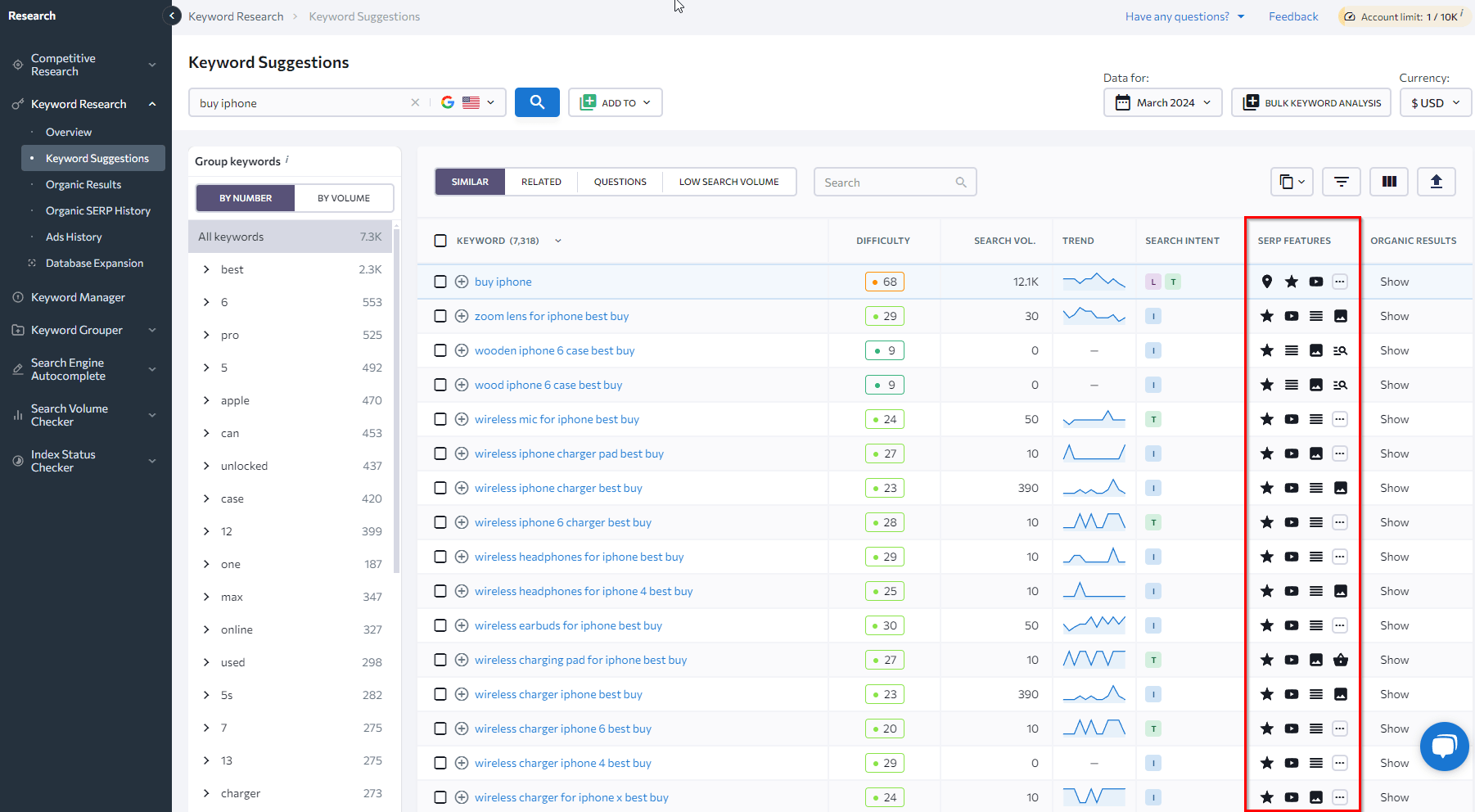
In addition, when you use SE Ranking’s Competitive Research tool, you can see SERP features your competitor optimizes for. For example, you can see that 7.9M keywords the domain targets get Video rich snippets on SERPs.

To see what those keywords are, click the Video feature tile and you’ll get the full list of keywords you can potentially optimize your media-rich pages for.
Besides that, you can see what rich snippets are displayed for every keyword that you track in your project.
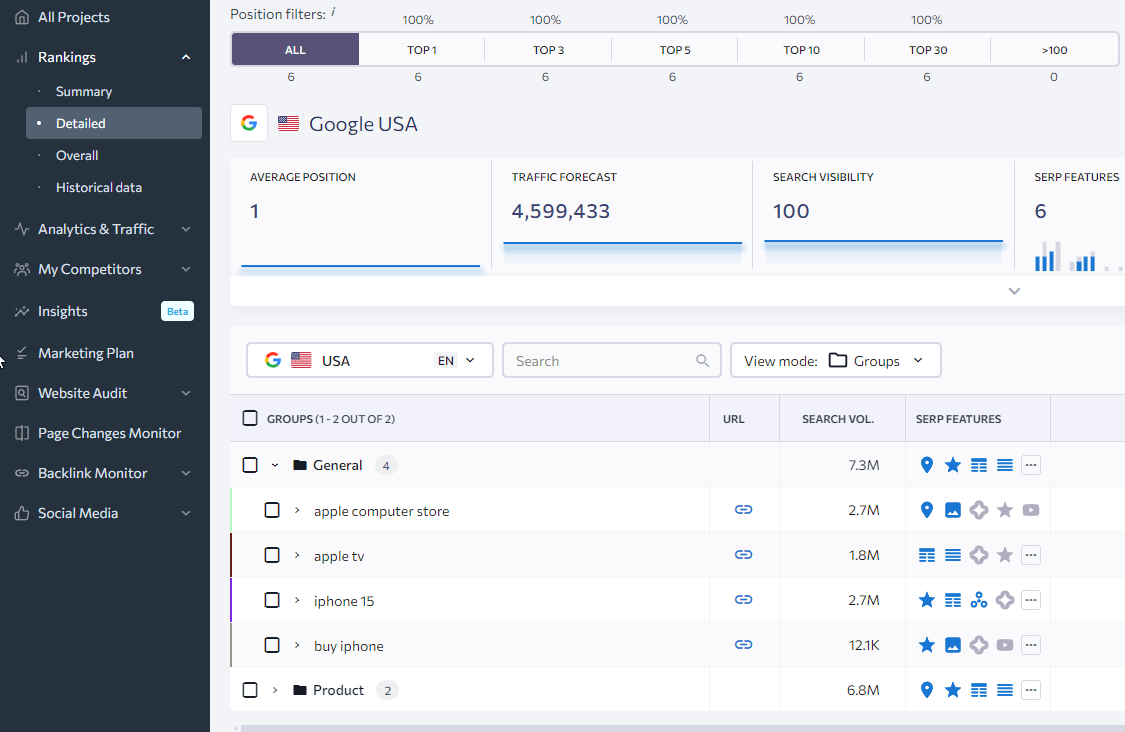
If you want to see the rich results that you’ve got, or could have got, check the Detailed report in the Rankings module.
Let’s avoid the terminology confusion!
When discussing rich results, people often misunderstand each other because of the inconsistent terminology. Google’s rich results naming has recently changed but people continue using different terms. Let’s sort out all the terms you’ll encounter when reading about rich results to avoid any miscommunication.
Featured snippets
The term “featured snippets” describes a separate category of SERP features located in position zero. Although some types of rich results and featured snippets look very alike, they are generated in totally different ways. You can quickly identify a featured snippet on SERPs by a specific About featured snippets link located at the bottom.
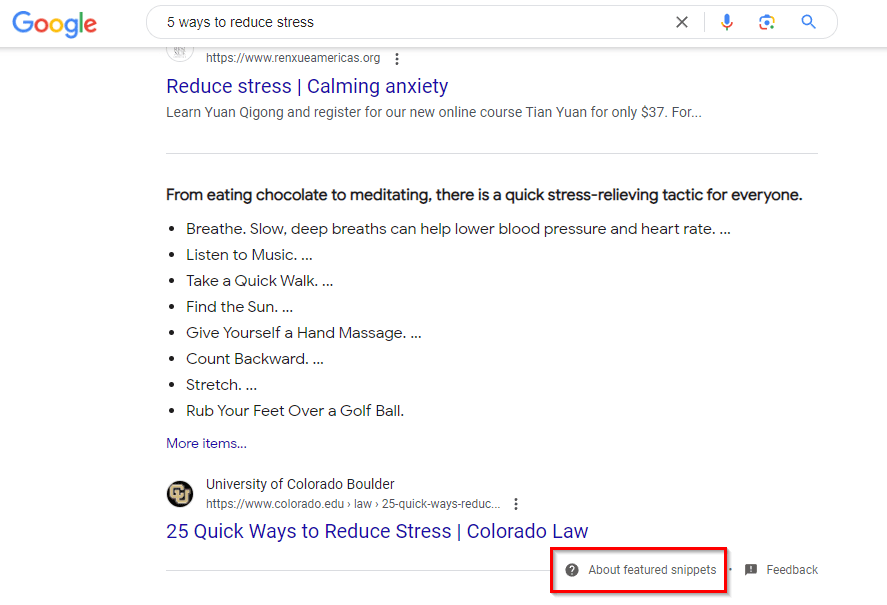
From the SEO perspective, the main difference between rich and featured snippets lies in your ability to optimize your pages to get them. Google doesn’t give any guidelines on getting a featured snippet but provides clear requirements for making content eligible to have a rich result. To figure out all the distinctions, read our article explaining what is a featured snippet.
AI Overviews
AI Overviews are another new search result type that you should know. AIOs use AI to generate direct answers to questions, and can include a variety of helpful information, including product recommendations, embedded videos, links to authoritative resource sites, step-by-step instructions, and more. The AI pulls together relevant information from multiple sources to provide users with comprehensive answers to their queries.
We recommend staying up to date with the latest developments in AI Overviews. Leading by example, our company, SE Ranking, has created an AIOs hub page where we gather all the latest updates on Google’s AI responses.
Download our research findings for exclusive insights!
Click the link we sent you in the email to confirm your email
SE Ranking offers an AIOs snippet detection feature in Rank Tracker, which lets you easily monitor your site’s AI Overviews with other SERP features. We are continually updating it to reflect new patterns in AIOs responses. Keyword-triggered AI snippets and other SERP features are shown in blue if your site has them.
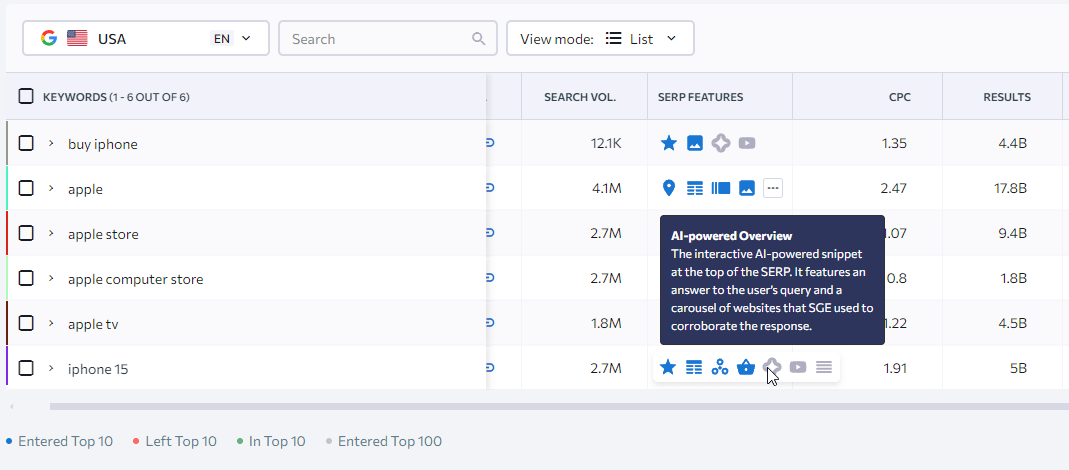
Rich results
“Rich results” is the most up-to-date term for visually enhanced elements of the SERP generated by search engines from a website’s structured data markup. This markup is added to pages to classify content. This helps search engines understand what entity type a page represents. Structured data is visible to search engines and not to users, and helps them understand different types of information on your website.
Enriched or interactive search results
An enhanced subset of rich results is called “enriched search results”. Enriched search results not only provide additional information, but also a special interactive user experience. For example, users interacting with Jobs enriched search results can find jobs near them, extend the list, apply additional filters to it, or bookmark job postings of their interest.
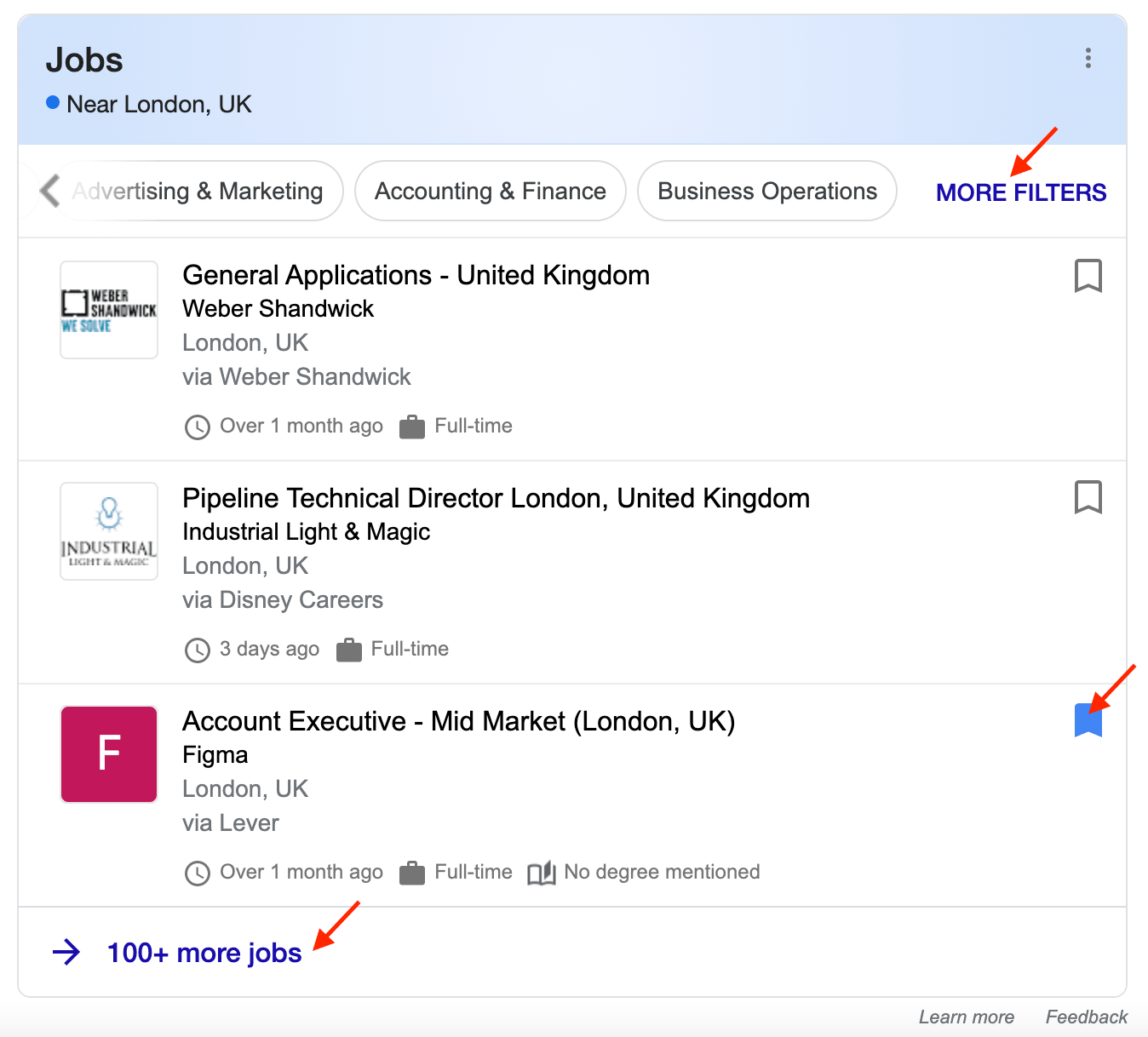
Another example of an enriched search result type is Recipe. If users encounter recipe rich snippets, they can see additional information, including user ratings and reviews, cooking times, ingredients lists, and recipe images.
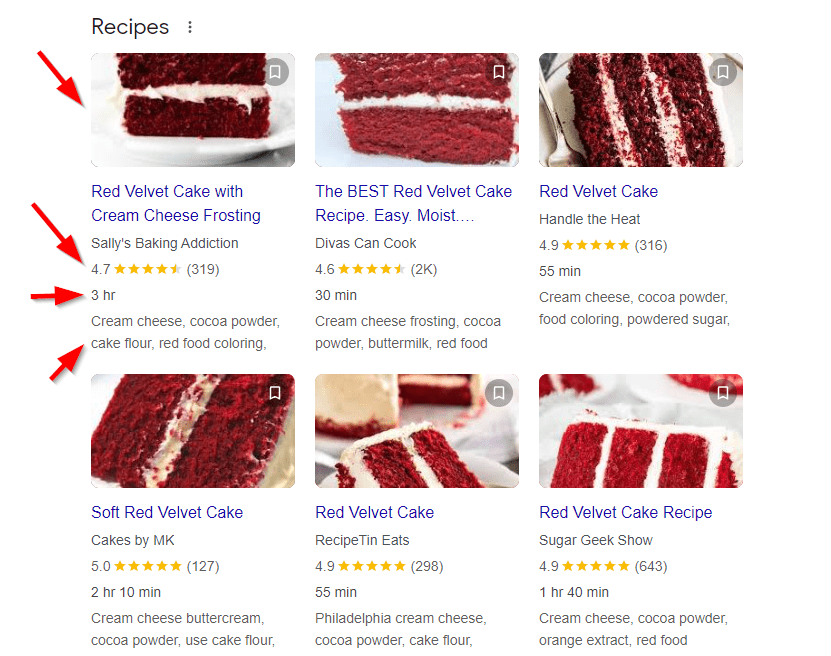
Event rich snippets are another enriched search type that supports an enriched search experience. They’re useful for users because they provide key event details, like the event’s description, location, date and time.
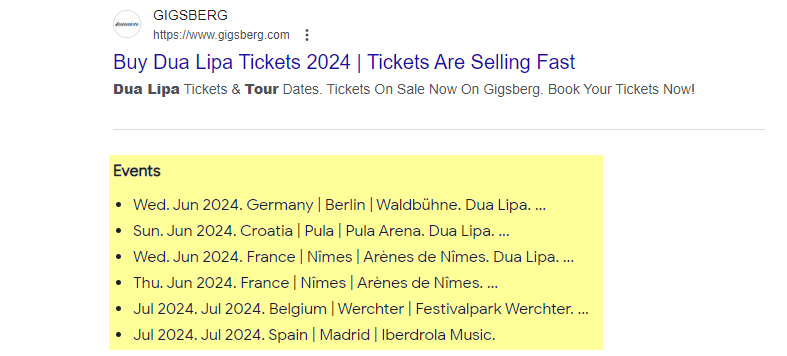
To get interactive snippets, you must comply not just with the regular Structured data quality guidelines but also with Enriched search quality guidelines. These guidelines ensure that your structured data is accurate, complete, and follows best practices for enriched search results, allowing Google to properly index and rank your pages.
Structured snippets
The term “structured snippets” belongs to a whole different area. It’s the name of an ad extension available in Google Ads. The structured snippet extension allows you to highlight some aspects of your products and services that make your ads stand out in the Search Network. As a result, your ad shows an additional line with a list of parameters that you specify in settings.

So that we’re on the same page, let’s agree on using the official term “rich results” and the one everybody is accustomed to “rich snippets” as synonyms. Now we’re ready to move on and make a brief overview of how rich results have changed since they first appeared on SERPs, where they stand now, and what we should expect in the near future.
A brief history of rich results
Up to 2008, Google’s SERP represented a list of equally structured snippets. This provided a level playing field for website owners. It was only the marketers’ approach to writing titles and descriptions that could make some pages stand out among others. But during the last decade, the picture has changed dramatically. Let’s go through the key milestones of the evolution of rich results.
The first two types of rich snippets
The history of rich results in Google SERPs started on May 12, 2009. That day, Google announced their experiment with a new presentation of snippets and invited webmasters to participate. Website owners could add structured data to their pages to get one of two types of rich snippets: People and Reviews. For this, they could use the microformats or RDFa markup to wrap particular data with additional tags in their pages’ HTML. The experiment was successful.
Schema.org and new markup types
During the next two years, Google added new types of rich snippets, namely, Recipes, Events, and Products, and started showing enhanced search results ten times more than in the beginning. As more webmasters got involved, the clearer it became that everybody needed a new convenient structured data markup. In June 2011, Schema.org was launched as a joint initiative from Google, Yahoo!, and Bing. Schema contained a lot of universal markup types used by the most popular search engines and became the new industry standard.
JSON-LD for structured data implementation
In 2015, Google started to support the JSON-LD format to ease the implementation of structured data markup. The main advantage of using JSON-LD over microformats or RDFa was in adding structured data as a separate script rather than editing the pages’ HTML.
Rethinking and expanding rich snippets
In May 2016, Google rolled out a new format for search results called “rich cards” for two types of structured data: Recipes and Movies. Rich cards were an advanced version of rich snippets with a better design tailored for the mobile web. In December 2017, Google expanded this approach to other types of rich snippets and renamed them into rich results.
Google now runs experiments with search features every few days, launching new ones or updating existing ones at a rapid pace. This has transformed the look and feel of SERPs from a simple list of links to an interactive panel packed with useful information at your fingertips.
Website owners and SEO pros must stay vigilant as Google continues to test all kinds of search features. Rich snippets have become increasingly important for SEO. They help websites stand out in search results, attract more clicks, and provide users with valuable information prior to site visitation.
Richer SERPs and user experiences
So far, rich results have evolved by leaps and bounds and made the SERP look much more diverse. The experiments with new designs and behaviors for rich snippets are ongoing and take the user experience on SERPs to the next level. Some types of searches return the users the so-called interactive or enriched search results: job postings, recipes, events, and products, just to name a few. And more advanced features are coming in at an exponential rate.
For example, rich snippets now allow users to perform basic interactions (like seeing more details, etc.) on top of complete actions like buying a product directly from the SERP. This enables ready-to-buy customers to go directly to your checkout.
"Buy now" in Google's popular product pack which adds the product directly to your cart from Google search 👀 pic.twitter.com/waRYUBvNUb
— Brian Freiesleben (@type_SEO) December 13, 2023
Users can even get a discount coupon directly from rich snippets.
SEO News: Google has now launched discount rich results for organic listings in the US. The new rich result type makes your snippet larger – allowing shoppers to copy coupon codes directly from search results. More details & history: https://t.co/A6BHhsfduY pic.twitter.com/02yS7pTPTB
— Brodie Clark (@brodieseo) January 29, 2024
They can sometimes appear not just features but entire interfaces. For example, they may appear as an ecommerce style interface with products and sales offers, grouped by category.
Interesting, when I search for "shop deals" I see an entire SERP of deals using that visual from your screenshot. It contains a boatload of deals per category. Takes up the entire SERP. This might be what Google is going to release fully soon (or now). pic.twitter.com/u5EZCZ3t5U
— Glenn Gabe (@glenngabe) November 2, 2023
Although the primary goal of rich snippets is to improve user experience, their implementation has a side effect. Rich results put website owners who have greater development resources at an advantage over those who can’t leverage structured data at scale.
Nevertheless, W3Techs’ statistics on structured data usage show that only 47% of websites currently use JSON-LD that is recommended by Google. If you haven’t implemented it yet, you still have time to jump on the bandwagon.
What rich results to go for?
At the moment, Google lists the 37 most commonly used rich snippet markup types for rich results on their search gallery. But the full list of schemas currently includes 806 items and is gradually extended as new types of structured data are used by search engines to provide better search results. Let’s look at some rich snippets that generate rich results on Google SERPs.
Rich results that belong in every industry
Let’s first go through rich results that have been around long enough to prove they bring value to all sorts of companies. If any of the following rich snippets seem relevant to your website, you have every reason to optimize your pages for them.
Logo, Knowledge Panel, and Related Searches
All three types of rich results are generated from the Organization schema markup. This markup type is an absolute must-have for every business. It helps Google associate websites to the companies that own them and improves their brand SERPs.
Organization schema markup allows Google to show your company logo and some additional information in the Knowledge Panel on the left of the SERP.
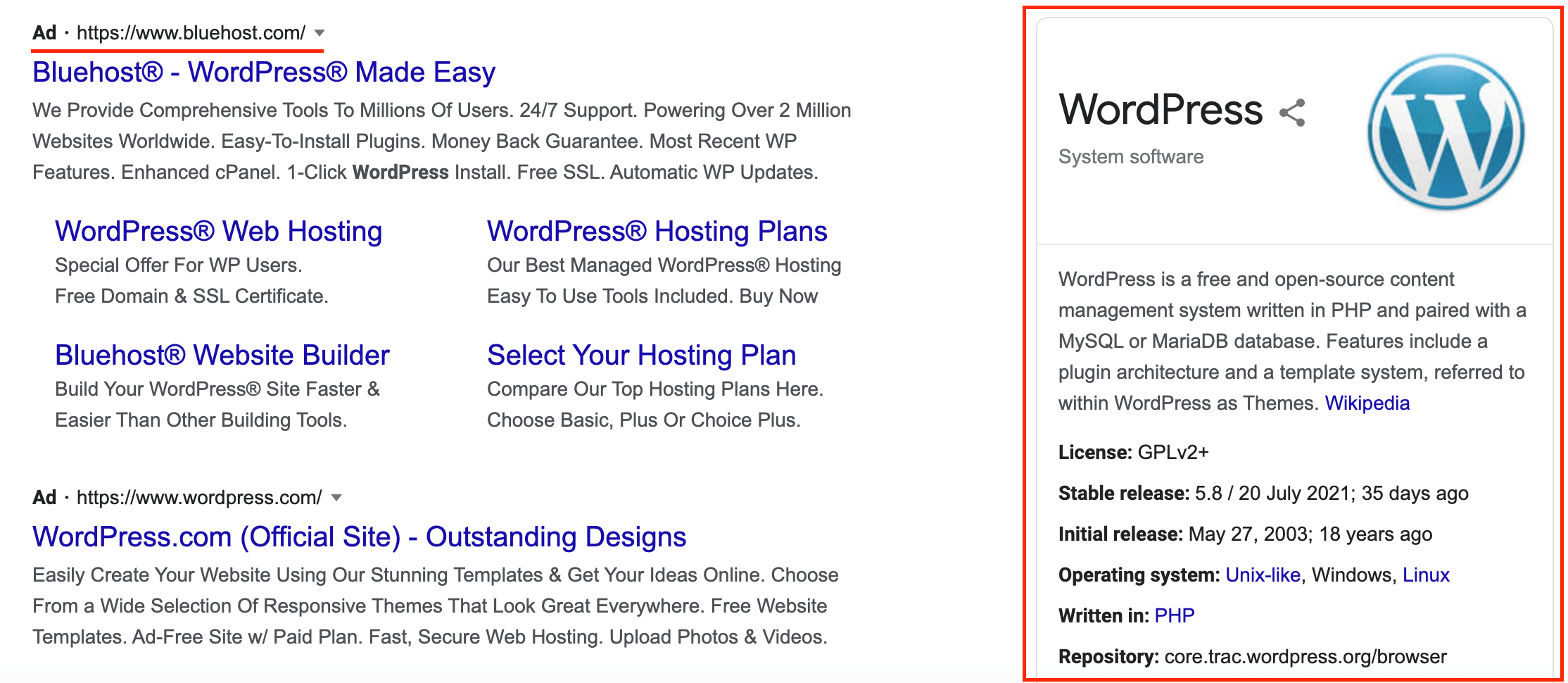
What’s even more interesting, Google will use your Organization markup to classify your business and compare it to other businesses. Once the search engine gets enough context, it will show your logo linked to your website in the Related Searches rich result. That’s how you can legally show up on your competitors’ brand SERPs. For example, when someone searches for WordPress CMS, they’ll see its competitors’ logos in the list of related searches.
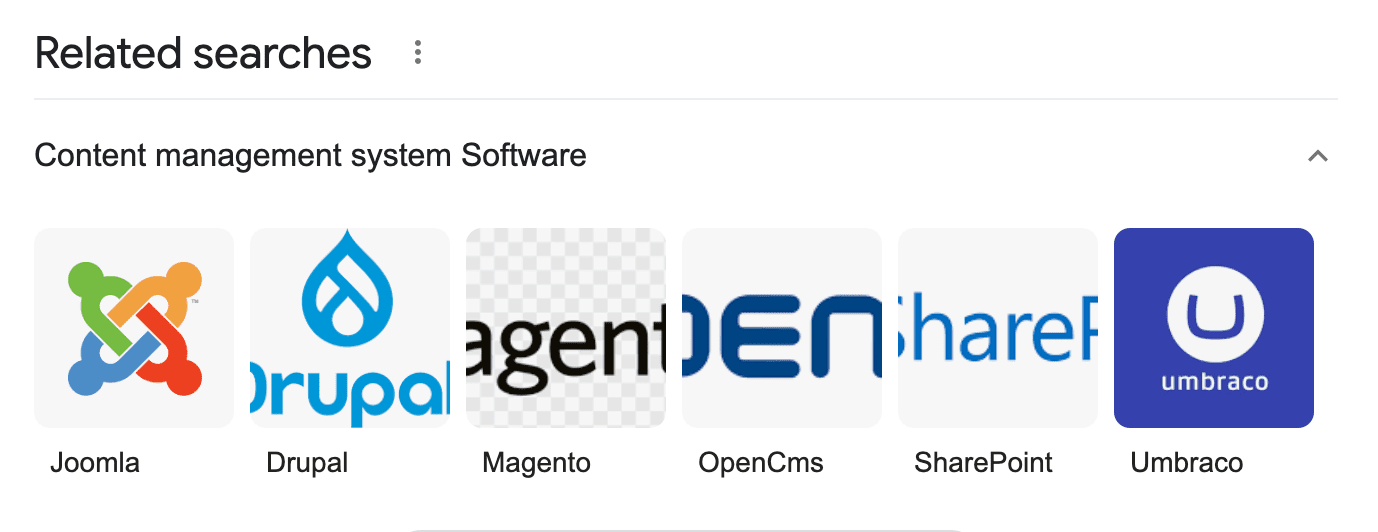
The more detailed and specific your Organization markup, the better. There are many subtypes for the Organization type in Schema vocabulary. The best practice would be to use the most specific markup subtype that applies to your company. Let’s assume you have a jewelry store website. You’ll need to go to Schema.org and drill down the hierarchy of the Organization markup subtypes: Organization > LocalBusiness > Store > JewelryStore.

The “People Also Ask” (PAA) feature is another important rich result. PAA boxes contain a list of questions related to the user’s search query and brief answers and links to source pages. When a user clicks on a question, the box expands to reveal the answer and may display additional related questions.

While PAA is similar to the FAQ rich snippet (FAQ rich snippets are now limited to government and health sites), there are some key differences:
- Google dynamically generates PAA questions based on search queries, while website owners create FAQ rich snippets using structured data markup.
- PAA answers are excerpts pulled from web pages, whereas FAQ answers are typically written by website owners and are marked up with FAQ schema.
- PAA results can appear for a wide range of search queries, while FAQ rich snippets are limited to pages with FAQ content.
Interestingly, Google has been testing new features for the PAA section. They have been expanding their testing of audio and lists within the PAA results.
Seeing some interesting tests with People Also Ask all weekend. They have a speaker on the left side, and it will read the question and answer (and will highlight each question word as it speaks). And the non-speaker icon ones act like a drop down featured snippet. pic.twitter.com/bupd3NDYQM
— Jennifer Slegg (@jenstar) October 30, 2023
Google has also been testing out different names for the PAA feature. They tried calling it “More to ask” a while ago, but they recently experimented with several other variations, including:
- “Related questions”
- “People are also asking”
- “Others want to know”
- “Often searched together”
- “Others searched”
- “What people be searchin'”
- “Also searched by folks like you”
All these tests show that Google has been working on improving the PAA feature and its usefulness for people looking for answers.
Video rich results
If you markup the videos hosted on your website, they may appear in general Google search results, video search results, Google Images, and Google Discover. Although, if you look at SERPs, you’ll quickly find out that most of the videos featured in rich snippets are hosted on YouTube. Therefore, if you want to own video real estate on SERP, it makes more sense to develop your YouTube channel. However, if the video is embedded on the website, it will be indexed only if it is the main content on the page.
In its basic version, the video rich snippet will be enhanced with a cover picture from your video and some additional information, such as publication date, and publisher.

However, Google’s page one often contains enriched search results for videos with key moments highlighted. Although Google’s algorithm can figure out key moments in your YouTube videos by itself, it’s recommended to guide it on what to show by using timestamps and labels in YouTube descriptions. If you add them, the interactive version of your video rich snippet will truly stand out on the SERP, dropping a shadow on all other snippets.
Interested in the power of video SEO marketing? Get expert tips and best practices from our guide to making your videos shine in Google search and boosting your overall YouTube strategy.
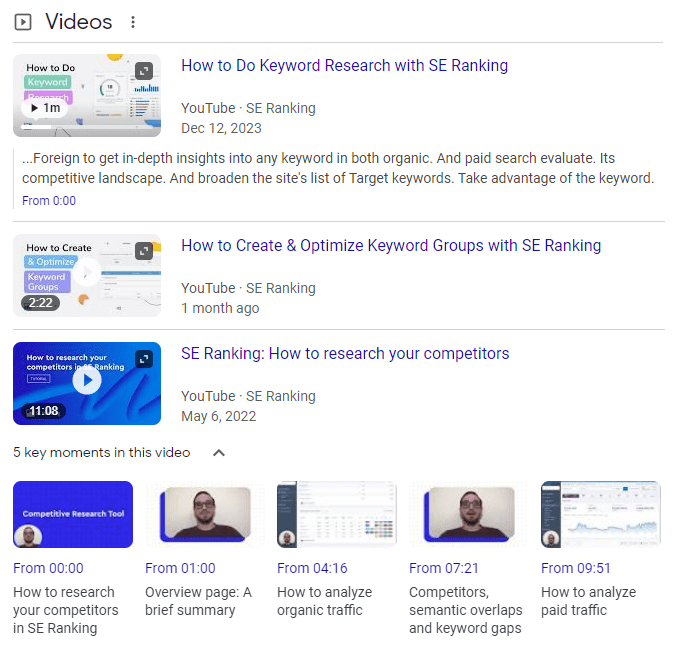
Videos can also be featured in AI Overviews (even with timestamps of the required video fragment).
Google is also great at helping websites optimize their video content for better discoverability and user engagement. For instance, by following Google’s best practices for Video SEO and using Search Console tools, several global content publishers have seen impressive results:
- Weather.com doubled its indexed video pages after implementing its video rich snippet markup, making it easier for users to find their content.
- Italiaonline achieved an 841% increase in video clicks, a 353% increase in impressions, and an 85% decrease in video indexing errors by adopting video structured data and Search Console best practices.
- ABP News, an Indian news publisher, optimized their video content across 8 regional languages using structured data, adopting video best practices on Search and piloting new features like Video key moments. This resulted in a 30% growth in traffic.
Review and Rating rich snippets
According to research by Customer Alliance, 91% of consumers read online reviews at least once a month. People seek social proof and trust online reviews nearly as much as personal recommendations. This makes review and rating rich snippet markups quite helpful for businesses striving to build trust and reputation. Whether you sell products, provide services to your local community, or promote a software application, you want to have those shiny five stars in your snippets.

There are several ways you can implement review and rating structured data:
- If you have a review for your business on another website, you can make it show up for one of your website’s pages. Let’s say you sell marketing software that got a great review on G2. Add the corresponding Review schema to one of your service pages and Google will associate the review from G2 with this page. The same review will show up in rich snippets for both G2 and the service page on your website.
- If you allow users to share their reviews directly on your product pages, you can markup this user-generated content and have it reflected in your snippets in the form of an Aggregated Rating, which shows the average rating and the number of reviews.
- Apart from using a simple Review or Aggregate Rating schema, you can nest them in another markup type using a review property. If you do this, your Products, Recipes, Events, and other rich snippets will include ratings and review counts.
Apart from improving your pages’ snippets, the review and rating schemas can be used by Google in Knowledge panels related to your business.
For example, searching for the movie “Dune” reveals its star rating and a Review button next to the title of the knowledge panel. You will also see detailed information centered around ratings, and an excerpt from the customer’s review in the bottom part.
Google does not publicly disclose the specific factors it uses to select reviews for rich results, but review quality, relevance, freshness, or reviewer authority (which are based on general SEO principles and observations) are among its key considerations.
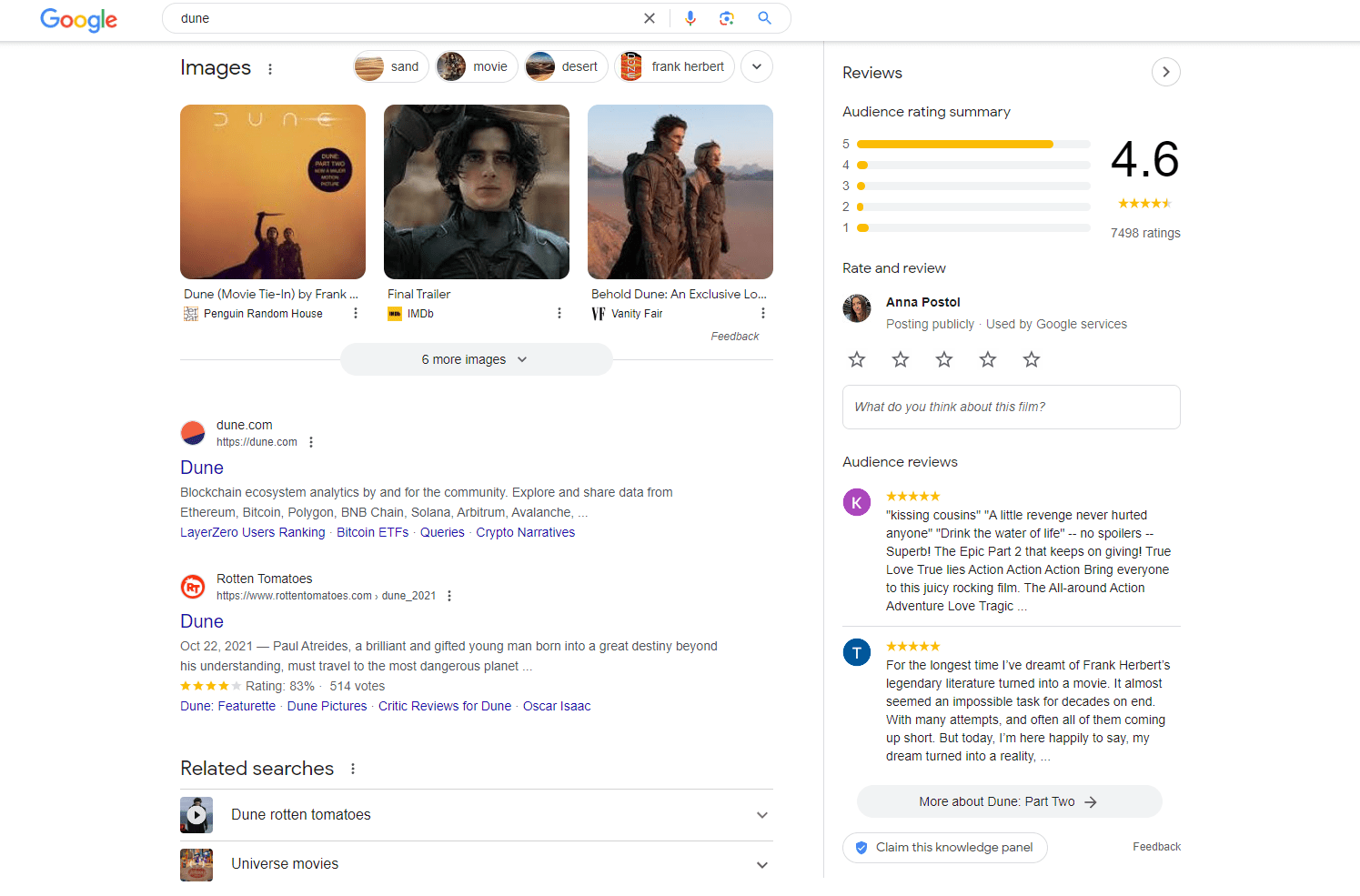
Top stories rich results
Businesses of all niches rely a lot on corporate blogs to attract and retain customers with the help of expert content. Now every website publishing content on trending topics has one more opportunity to distinguish itself. It’s about getting their articles listed in the Top stories rich snippet.
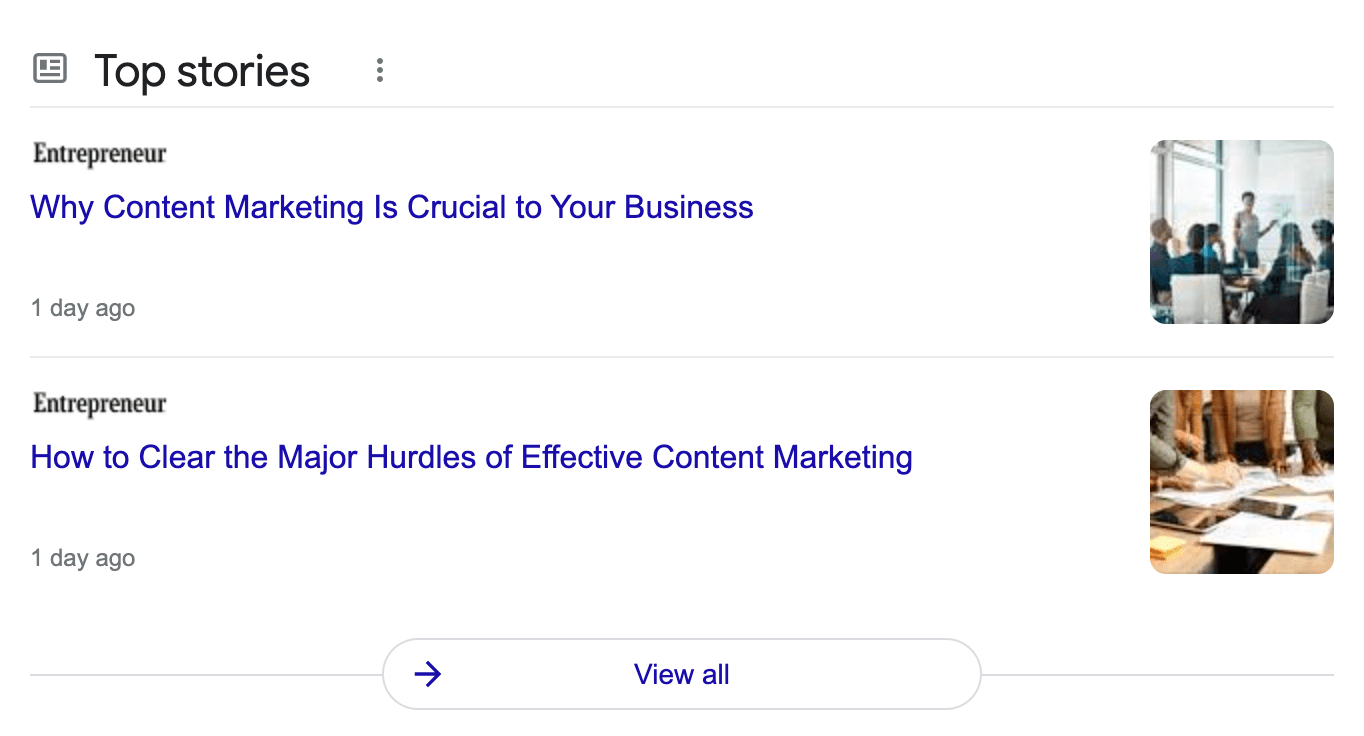
To get into Top stories, you need to publish high-quality content created by industry experts to comply with Google’s E-E-A-T (experience, expertise, authoritativeness, and trustworthiness) requirements. But in addition to that there are several small tips to raise your chances of getting these rich snippets:
- Add Article schema markup to your page.
- Include a keyword in your H1 headline as it will be shown on SERPs.
- Keep your article headlines short so that they are not cut on SERPs.
- Don’t use clickbait headlines that may be flagged as inappropriate.
- Add all the required images (one image 1.200 pixels wide and having 800.000 pixels in total, and multiple high-resolution images with the aspect ratios of 16×9, 4×3, and 1×1).
Adding Article markup to your pages not only makes them qualify for Top stories rich snippets but also helps them get displayed on Google Discover.
Users are currently able to follow topics they’re interested in. Google considers a user’s activity and search history to provide personalized recommendations. It suggests posts that the user hasn’t read yet but is likely to find interesting based on their previous interactions.
Local Pack rich snippets
The good-old Local 3-Pack has been updated several times since it was first rolled out in 2014. Its enriched version lists your business among the top three options for searches with local intent and allows people to book your services or make reservations right from the SERP.
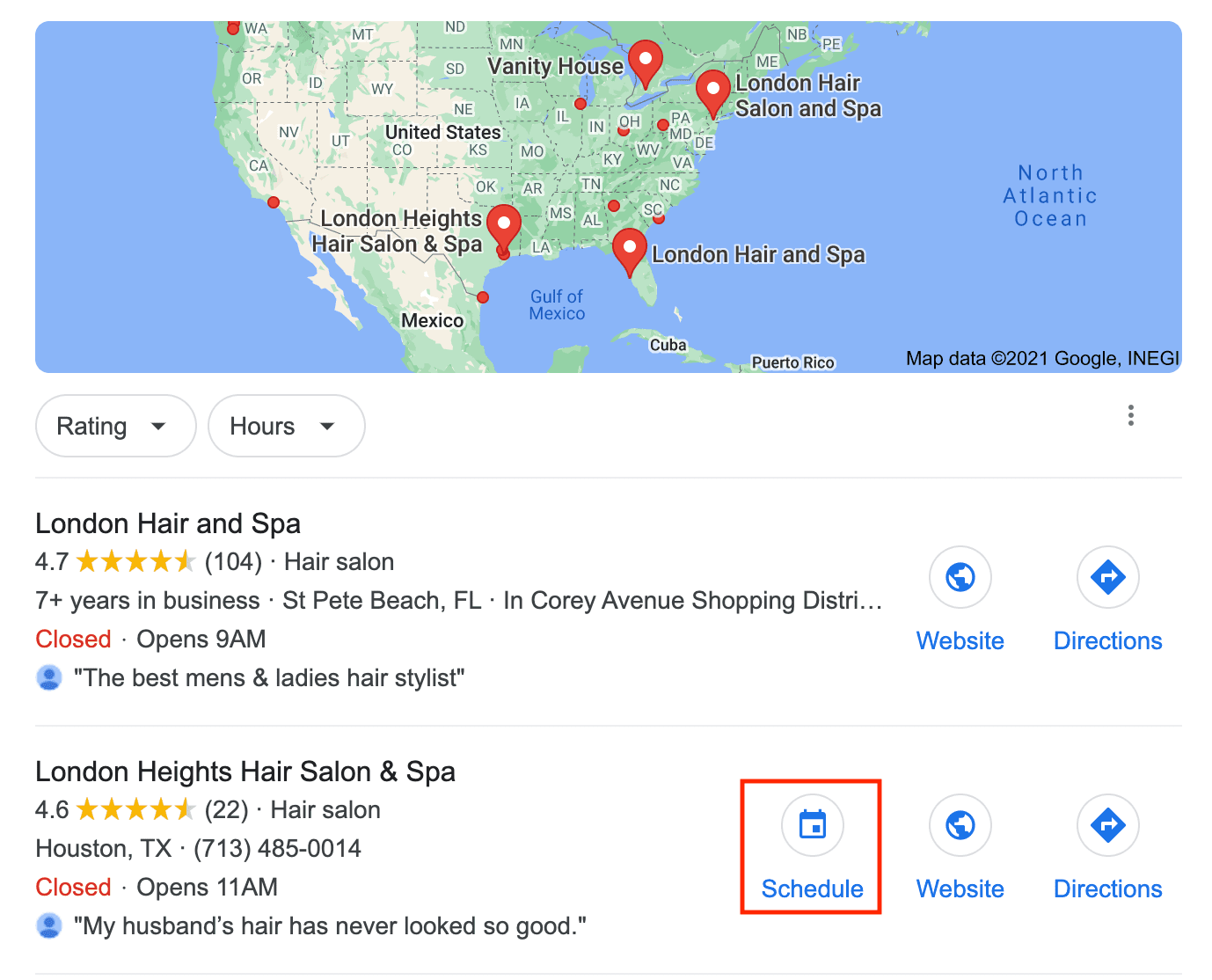
This type of rich snippet is powered by the Local Business markup. It can pull the structured data about your business address, opening hours, phone number, ratings, website links, etc. It uses your geo coordinates to show your business on the map and lets users find Directions.
Google constantly extends the labels range and other information about businesses shown on the listing. It pulls this information from various sources, including websites, Google My Business (GMB) data, customer reviews, and other data sources.
For instance, Google has been recently testing the display of restaurant price ranges, like $10-$20 or $20-$30 per person. It aims to help users find good options that fit their budget.
More examples of Google showing prices for local restaurants in Melbourne, Australia.
— Gagan Ghotra (@gaganghotra_) February 23, 2024
I see this show for every restaurant that I'm searching on Google. https://t.co/Wk7F132fzO pic.twitter.com/qdXjfSPefB
Another example is Google’s testing of a new design and feature for its local justifications section. They introduced a blue-highlighted “people like” section that showcases aspects of a business that people praise in reviews.
🆕 People like add ons in google local packs
— Khushal Bherwani (@b4k_khushal) February 28, 2024
Saw the first time @rustybrick new ?#localbusiness pic.twitter.com/8XNabFFd5x
But Google isn’t stopping there. The search giant is continuing to expand the list of available actions that users can complete directly from the SERP. This includes getting a ticket for an activity or booking a room. You can use the Maps Booking API to let users make reservations, orders, or perform other actions directly from SERPs.
For example, we spotted a new Google feature that displays a user’s existing reservations made using the “reserve with Google” feature. It appears directly in the local pack rich snippets.
First time seeing a personal reservation (via reserve with google) display on a GBP listing 👀 pic.twitter.com/BkkD8zxm4A
— Krystal Taing (@krystal_taing) April 2, 2023
Merchant listings
Google Search has different shopping features called merchant listing experiences that appear directly in search results. These product searches rely on specific data and include product snippets, popular products, shopping knowledge panels, and image search results.
To participate in these merchant listing experiences, you must provide Google with rich product data. You have two options:
- Add Product structured data to your web pages
- Upload data feeds via Google Merchant Center and opt into free listings within the Merchant Center console
Google recommends doing both if possible. This provides you with the best chance of showing up in Google’s shopping tab and features. It also helps Google correctly understand and verify your data. Google will occasionally mix info from your structured data and Merchant Center to create your product listing.
In addition to well-known product snippets with detailed product information like ratings, reviews, prices and availability, Google constantly develops new features to seamlessly integrate the shopping experience into SERPs. Among its newest features are the “latest styles” and “shop the look” carousels for clothing-related queries. These interactive carousels showcase various outfits, automatically updating product listings as users swipe through different looks.
🆕 Google with new dedicated carousal section for latest style
— Khushal Bherwani (@b4k_khushal) February 21, 2024
Swipe categories changes the product and brand as saw in video#ecommerce#SEO pic.twitter.com/7gZCD2JiGi
Another exciting development in Google’s shopping features is the recently launched “Shop with Google AI” tool. This AI-powered feature allows users to generate images of desired clothing items based on verbal descriptions to find similar-looking products.
I think Shop with @Google AI is live. You can generate images of the item you're looking for and shop for similar-looking products. This looks super cool! #AI #ShopwithAI #GoogleAI@rustybrick pic.twitter.com/owRYxK3goR
— Shameem Adhikarath (@shemiadhikarath) February 16, 2024
You may also like Google’s new “Related categories nearby” section. It shows related categories whenever you search for a product. You can click a category to see nearby stores that sell both the item you’re looking at and other relevant products.
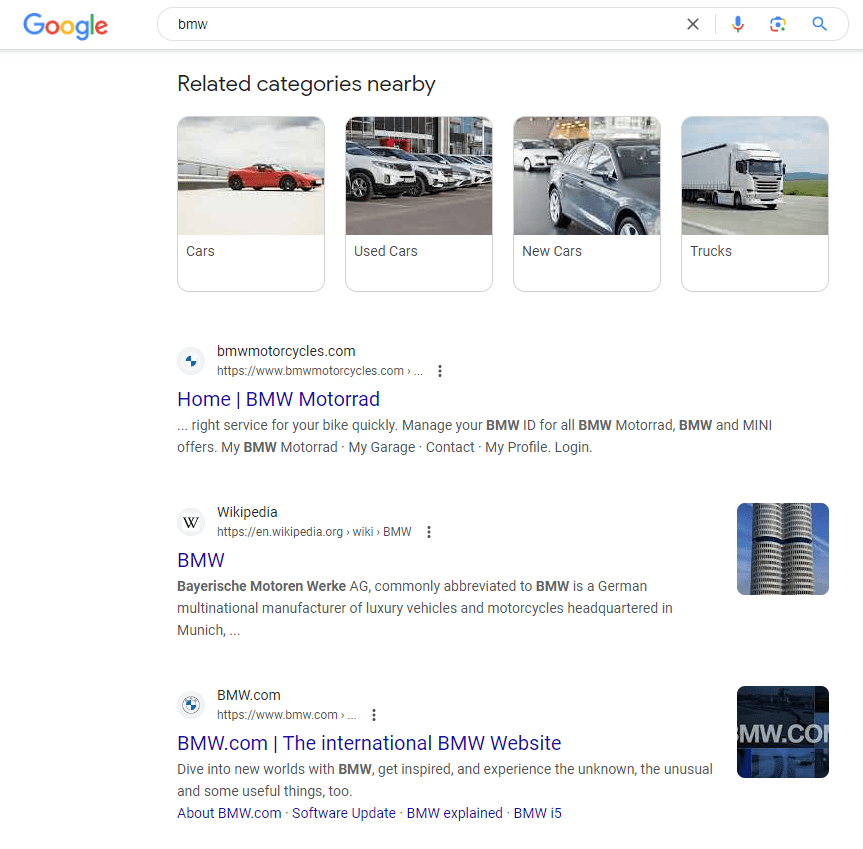
Google also constantly adds and updates features for product results. For example, Google now highlights if a product’s price is at its lowest within a 30-day period. This feature appears in the product listing results, with the “Low price” label displayed in green font along with the words “30-day low.”
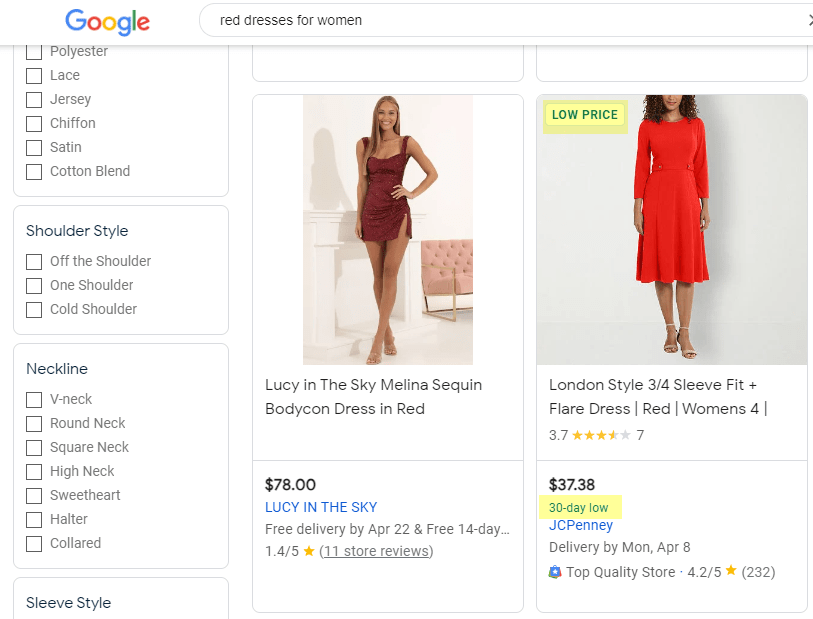
You can also see delivery estimates directly from the product listing level in search results.
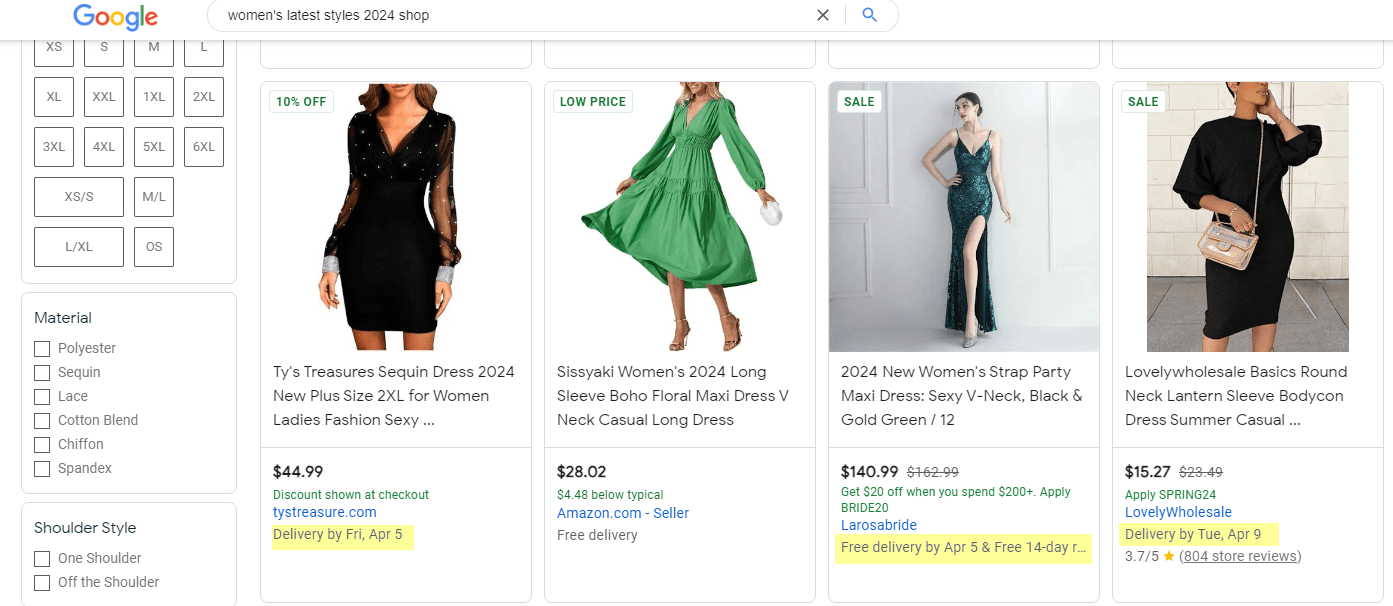
Google now supports Product variant structured data, making it easier for ecommerce sites to display product variants in search results. The new properties (hasVariant, variesBy, and productGroupID) group variants under a single “parent” product. This update works in Google Search through structured data and improves merchant center feeds, enhancing the online shopping experience for users.
Google will undoubtedly continue running these Google shopping experiments, with more innovative features and enhancements just over the horizon. As Google continues to leverage advanced technologies like AI and machine learning, we can expect to see increasingly personalized and intuitive shopping journeys directly on the SERP.
Next-gen enriched or interactive search results
We’ve already mentioned an enhanced subset of rich results called “enriched search results” that create a special user experience on SERPs. Let’s explore a couple of examples of interactive search results in a bit more detail.
Special announcement
Special announcements are a new type of markup for enriched search results. The feature is currently in Beta. It only works for local and national resources and announcements, such as facilities closures, travel restrictions, openings of testing or vaccination centers, or disease spread statistics and maps.
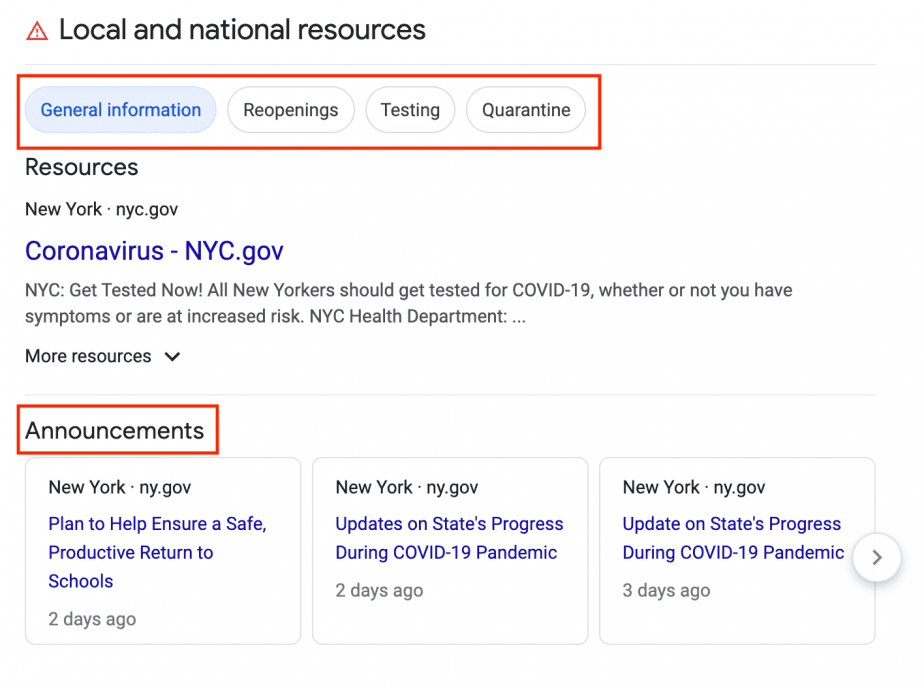
After this type of rich snippet is fully implemented, it will apply to different situations. For example, you might need to use it to let people know about a closure, event reschedule, or revised business hours during an emergency.
To do this, you’ll need to add the SpecialAnnouncement schema markup to your urgent information, publish your page, and submit it to Google through Search Console. Google will generate different rich snippet types that will target your area. The announcement will expire after the date that you specify in the markup that indicates when the information is no longer useful.
Software app
If you sell software that integrates with third-party apps, you might have a marketplace with all your partner apps listed. If you want the snippets from your marketplace to look nice, add the Software Application markup to the app’s pages on your marketplace. It will make your content eligible for getting Software App rich results that show app category, ratings, price, file size, current version, or other parameters.

Snippets from your own app marketplace will look just as good as those from Google Play and Apple App Store.

Schema vocabulary also provides tags to describe properties specific to mobile apps, web apps, and video games. Whether you want to show your video game genre or list the key features of your business app, it’s got you covered.
Remember that most of the enriched search results are experimental ones. Before optimizing for any of them, check whether they work for your niche from both business and consumer perspectives.
Some of the enriched search result types may stick around for years and benefit your business, like they have for the snippets for Jobs, Events, and Recipes. Others may get deprecated for not bringing value to the ecosystem, as it was with the Critique Review snippets. Some just won’t fly because very few website owners opt for them; as was the case for the Speakable snippet.
Optimizing for enriched search results entails significant investment in sophisticated schema markup implementations. If you want to do it, you should have strong reasoning behind your initiative to get real buy-in from all stakeholders. Let’s see what the benefits are of rich snippets for SEO.
Do rich snippets help SEO?
Structured data is not a ranking factor, but it does help search engines put together a clearer understanding of your pages so it can display them on SERPs better. Leverage markup to increase your chances of getting rich snippets for any business (the earlier the better).
Now, let’s take a look at the advantages rich snippets bring to the table.
- Rich snippets steal the show. Enhanced search results outshine simple blue links and squeeze your competitors away from people’s attention and sometimes even from Google’s first page.
- More clicks to your pages. Pages using schema markup received a 40% higher click-through rate than pages without it. This suggests that they have higher traffic potential.
- Rich snippets quicken users’ journeys. With interactive snippets on SERPs, you let customers make buying decisions, locate your business, or book your services in fewer clicks.
Now you have to upgrade your approach to SEO with an On-SERP SEO strategy. Not only should you know the search volume for the keyword you target, but also check what type of rich snippet it triggers.
Go to our Rank Tracker tool to see which Google SERP features your website has. Our tool currently allows you to track over 32 SERP features. Follow the steps below to see how your page appears in Google SERPs:
- Go to your project >> Rankings >> Detailed.
- Look for icons next to your keywords. A blue icon means your page has a SERP feature for that keyword. A gray icon means someone else’s page has the feature. If there is no icon, no SERP feature exists for that keyword.
- To customize the SERP features you see, just click “Filters” and pick the ones you want from the list. This makes it easy to spot keywords for which your pages have SERP features and areas where you can improve.

You can also track SERP features for your competitors’ keywords through Competitive Research or by going to the Keyword Research and Keyword Suggestions tab. This section displays related keywords that trigger specific SERP features.
Now that you know you need rich snippets in any case, let’s talk about how you can get them.
How to get rich snippets?
On Search Central, Google explains in detail what you should do to make your page qualify for rich snippet results. Yet, if you comply with all their rules, you don’t get a guarantee. Nevertheless, type a target query in Google’s search bar: if someone else has managed to get rich results, it means you also can.
In a nutshell, the optimization for rich snippets often boils down to adding Schema.org structured data markup to your website’s pages in four steps:
- Check what Schema markup you need to qualify for a particular type of rich snippets.
- Add Google’s recommended JSON-LD script containing all the required markup to your pages.
- Verify that your structured data is correct using Google’s Rich Results Test tool.
- Update your page and submit it for indexation through Google Search Console.
When the search engine visits your updated page and reads the structured data, it reindexes this information. It then analyzes your content based on user queries and intent to determine rich result eligibility.
Nonetheless, if the process was as straightforward as it seemed at first glance, there wouldn’t be that many pages of documentation on the matter. As soon as you try to implement structured data on your website, you’ll see it’s a long path full of pitfalls. Let’s look at how to approach structured data and rich snippets.
Note: Google sometimes understands the content’s page type from the content alone, even without the markup, and displays them in rich snippet results.
Choosing the format for rich snippets and schema markup
Theoretically, there are three formats that you can use to implement structured data: microdata, RDFa, and JSON-LD. But only JSON-LD technology will allow you to leverage structured data to the full extent and at scale. The former two are still supported but have become outdated.
JSON-LD is a method of encoding linked data that builds upon the JSON data exchange format that is widely used in web development. To get an idea of what those code snippets can look like, go to the JSON-LD Playground and try some basic structured data examples. You’ll quickly grasp that to add JSON-LD directly to your website code, you should be a JavaScript developer yourself or hire one.

Here we should warn you about a common mistake webmasters make when they start with structured data. It may seem that you can just copy prewritten JSON-LD pieces, edit them, and paste in the HTML code page by page.
Such a manual approach has two major drawbacks: it’s unscalable and inflexible. Imagine Google updates its requirements to the schema markup that you’ve already added to 300 pages. You’ll have to manually fix the code overnight to avoid losing all of your rich snippets—and it’s a pain.
Luckily, adding JSON-LD to your website code is not the only way to implement structured data for rich snippets. If your website is powered by a popular CMS, you’ll be able to use one of the available plugins for structured data. Plugins will provide you with a user-friendly interface to input your information and get it marked up in JSON-LD automatically. Let’s zoom in on how it works in different CMSs.
How to add rich snippet markup in WordPress
If you have a WordPress website, you can choose between several plugins for structured data. Yoast SEO and Rank Math are some options that you can download from the WordPress marketplace and install on your website.
If you choose Yoast SEO, you’ll be able to add the Organization schema markup to your website as you configure the plugin. For this, add your company name, logo, social profiles, and other relevant details at the Organization or Person tab of the configuration wizard. After you do this, your website will qualify to receive a beautiful and informative Knowledge panel that shows up on the right on your brand SERP.

Additionally, you’ll have special Yoast content blocks available in your WordPress block editor. If you want to add the FAQ, How-tos, or breadcrumbs to your website, just use the corresponding content blocks. Yoast will add the correct schema markup behind the scenes.

By using the Yoast SEO plugin for WordPress, you’ll have enough tools to get rich snippets for a business website that has a blog. Yet, if you run a WooCommerce-powered online store and want to unlock extra tools and features for ecommerce SEO, you’ll have to update to premium and enable the Yoast WooCommerce SEO plugin. This will help you get rich snippets for product and category pages.
How to get rich snippets for ecommerce stores
Rich snippet types for ecommerce websites require going beyond the basic schema markup implementations. The most useful rich snippets for online shops include the ones we mentioned earlier, including Product snippets with detailed product information, Ratings and Reviews, Prices, Shipping, Offer Availability, Location, etc.
Joining the Google Merchant Center and Google Shopping
To maximize your ecommerce store’s visibility and performance in search results, join the Google Merchant Center and the Google Shopping service.
The Google Merchant Center is a free platform for merchants to manage their product data and create product feeds. Here are some things you can do in Google Merchant Center:
- Upload, edit, and optimize your product information, including titles, descriptions, images, prices, and availability.
- Create and submit product feeds to Google Shopping and other Google services.
- Access a dashboard to track your product performance, impressions, clicks, and conversions.
- Configure your appearance in various Google programs, such as Google Shopping and Google Ads.
Google Shopping is a free service that displays product listings to users based on the data provided through the Google Merchant Center.
Both Google Merchant Center and Google Shopping are free to use, but you also have the option to buy ads to further promote your products. However, your product listings on Google Shopping will be considered as organic search results, even without ads.
Also consider that every ecommerce CMS offers its solutions for how to implement rich snippets, be it special extensions or detailed documentation for developers. Let’s look at what you can do with schema markup in Shopify and Magento.
Adding rich snippet markup for Shopify stores
When you create a Shopify-powered store, you choose a theme to define your website design. Some themes already include basic schema markup. However, you might want to implement a more complete and custom markup to get more informative rich snippets.
The first way to approach structured data in your Shopify store is to edit your website’s theme code manually. To access your Theme files, open your Admin panel home page, go to the Online Store page, select the Customize Theme tab and click the button to see customization options.

Then, select the Edit Code option to expand the drop-down menu and click Customize to open the folder where your theme files are stored.

Under Edit Code, you can look into the code that different types of pages have on your store. You should find the default JSON-LD scripts and check if you want to edit or swap them for alternative scripts.

If you’d rather avoid editing your store’s code, you can customize the default JSON-LD markup using Shopify apps for SEO. You’ll find several paid apps on the Shopify App Store, for example, Plug-in SEO or JSON-LD for SEO.
Adding rich snippet markup in Magento
Magento is a more complex CMS and you can hardly approach it with DIY guides. Instead, you’ll have to ask your developers to add all the needed structured data to your Magento store. They can do it either manually or using paid extensions from the Magento Marketplace, such as those built by Atwix, Magmodules, Mageworx, or WeltPixel.

Implementing structured data for ecommerce websites requires a careful approach. There’s no place for temporary DIY solutions that may lead to errors and data inconsistency. If your schema markup gives search engines misleading information about your products, like wrong prices or shipping details, your website can get disqualified from showing rich results.
How to add rich snippet markup for Wix websites
Wix is one more CMS platform that allows adding structured data to get rich snippets for business sites. Unlike WordPress, Wix doesn’t require you to install any additional plugins for handling structured data. Instead, it provides a built-in rich snippets tool with a user-friendly interface.

To add custom Schema markup, you should open a particular page in your Website Editor and go to Page Settings. Under the Advanced SEO tab, paste your JSON-LD script in the Structured Data field. After you apply the changes, check your page’s URL in Google’s Rich Results Test tool to make sure the markup you added is correct. For the tool to process your page correctly, make sure that you don’t block your page URL from crawling in robots.txt.
Using Google Tag Manager for JSON-LD markup
One more way to optimize your pages for rich snippets is by adding JSON-LD scripts to Google Tag Manager. This approach has some limitations in terms of scalability because you’ll have to add every JSON-LD script as a separate tag that fires on a particular page. Still, it’s the way to go if you can’t edit your website’s code or don’t want to install any special plugins. Here’s what you should do:
- Get a JSON-LD script template for the specific structured data type you want to use.
- Fill the template with the actual data from your website and test the code using Google’s Rich Results Test tool.
- Add the script as a new tag to your Google Tag Manager and test the URL of the page in the same Rich Results Test tool.
Now let’s focus on the third step. Once you have a JSON-LD script that you want to add to your website, open your Google Tag Manager and click Add A New Tag.

Among the available types of tags, choose Custom HTML and paste your JSON-LD script in the Tag Configuration field.

Then move to the Trigger Configuration section and add a new trigger for the tag to fire under certain circumstances. You’ll want your JSON-LD to fire when a particular page is viewed. Select the Page View trigger type, then select the Some Page Views option, and specify the URL of the page where your structured data belongs.

Publish the tag, and you’ll be able to test your markup for rich snippets and make sure the JSON-LD script works as intended. If you apply some advanced schema markup, you can also check it using the Schema Markup Validator tool at Schema.org.
Now you know several ways to add structured data to your website but does that guarantee that you’ll get rich snippets? Let’s look at some cases where you might not get the desired result.
Why are rich snippets not showing in search results?
The best part about optimizing for rich results is the fast effect you can achieve. Assuming your page code passes the Rich Results Test, it qualifies for getting rich snippets as soon as the search engine indexes it. Nonetheless, you need to keep an eye on structured data for several reasons:
- No guarantees. You might do everything right, but there’s still a chance Google won’t pick up your structured data for rich snippets. Even if you get them, it doesn’t mean you’ll have them forever or they’ll work equally well on SERPs for different locations. Nevertheless, without structured data your chances to get rich snippets are close to zero.
- Changing requirements. Google continues testing formats and markup requirements to improve rich results and sometimes even deprecates rich snippets that prove to be unhelpful for users. You may add valid structured data to your page but Google then stops showing that particular type of rich snippet.
- Complex syntax. Although there’s no lack of guidelines and examples for standard use cases, it’s still difficult to create custom or advanced markup. Mistakes in structured data or its incompleteness disqualify your pages from getting rich snippets.
- Conflicting formats. Structured data markup on your website should be added in one of the available formats: JSON-LD, Microdata, or RDFa. When you move from older formats to JSON-LD, you should clean all the previous markup from your website code which is sometimes difficult.
- Subject to errors. Structured data lives in your website code and can be affected by the changes you make to your website. Any time you roll out a major update, be sure to check if it hasn’t broken your JSON-LD scripts. And conversely, adding or removing structured data can break other parts of your website’s code.
The fastest way to spot issues with rich snippets is to check your Google Search Console reports. There you’ll find separate reports for every type of rich snippet shown for your pages on SERPs.
Does your business need rich results?
The short answer is yes. The rise of rich snippets on SERPs has changed the rules of the SEO game. The companies that invest in structured data implementation now gain a significant advantage over those that don’t. Although, some companies certainly have more reasons to embrace rich results than others.
If you own a local business—for example, a restaurant or a hair salon—ratings and reviews can influence your bottom line a lot. Having numerous rich snippet types with stars and testimonials will raise your credibility in the eyes of potential new customers. What’s more, getting featured in the Local Pack will let you have your services booked right from SERPs.
Brick-and-mortar locations are not the only type of business that badly needs to get rich results right now. In the internet industry, there are niches where rich snippets already own 100% of page one on Google. For instance, if you want to compete in the recipe websites niche, you simply won’t make it to page one without having schema markup. Just google for a “cheesecake recipe” and you won’t see a single standard blue link, not even on the second page.
The race for Google rich snippets may not have affected your industry yet. But it’s only a matter of time until your competitors find a way to benefit from these SERP features. If you hesitated about optimizing your website for rich snippets, act now. Rich snippets for SEO are important as you can get quick wins in traffic and conversions with a minor effort.

